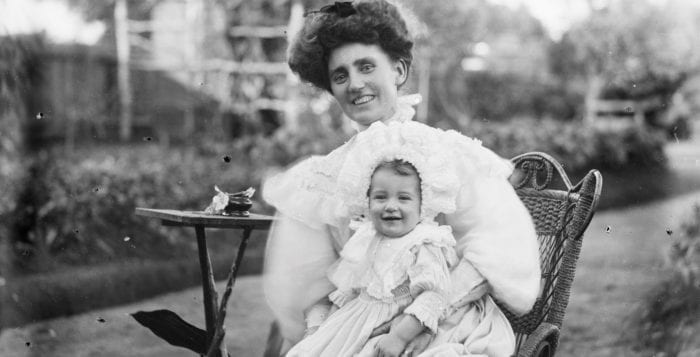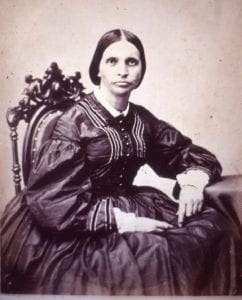History: Oh baby! Birth at sea

Whaling wives in the 19th century faced daunting challenges

By Nomi Dayan
As I prepare to become a mother for the third time around, I am brought to reflect on one of the most dirty, reeking and unlikely places possible to birth a baby: a whaleship. Today’s challenges with pregnancy and childbirth pale in comparison with the experience of the 19th-century woman — and even more so, the challenge whaling wives faced at sea.
Because whaling wives saw so very little of their husbands, some resorted to going out to sea — a privilege reserved for the wife of the captain. Aside from dealing with cramped and filthy conditions, poor diets, isolation and sickness, many wives eventually found themselves — or even started out — “in circumstance.”
In the 19th century, pregnancy was never mentioned outright. Even in their private diaries, whaling wives rarely hinted to their pregnancies. Some miserably record an increase in seasickness. Only the very bold dared to delicately remark on the creation of pregnancy clothes. Adra Ashley of the Reindeer wrote to a friend in 1860, “I am spending most of my time mending — I want to say what it was, but how can I! How dare I!” Martha Brown of Orient was more forward by mentioning in her diary in 1848 that she is “fixing an old dress into a loose dress,” with “loose” meaning “maternity.”
Once the time of birth approached, women at sea faced two options: to be left on land — often while the crew continued on — or to give birth on board. Giving birth on land was far preferable, as the mother would be theoretically closer to medical care and whatever social support was available. Martha Brown was left in Honolulu — much to her personal dismay to see her husband depart for 7 months on the Lucy Ann — but fell into a supportive society of women, most left themselves in similar situations.
During Martha’s “confinement” after birth when she was restricted to bed rest, a fellow whaling wife nursed her. When Captain Brown returned, he wrote to his brother: “Oahu. I arrived here and to my joy found my wife enjoying excellent health with as pretty a little son as eyes need to look upon. A perfect image of his father of course — blue eyes and light hair, prominent forehead and filled with expression.”
Giving birth on land did not always ensure a hygienic setting as one would hope. Abbie Dexter Hicks of Westport accompanied her husband Edward on the Mermaid, sailing out in 1873. Her diary entry on the Seychelles was: “Baby born about 12 — caught two rats.”
Some whaleships found reaching a port before birth tricky. In 1874, Thomas Wilson’s wife Rhoda of the James Arnold of New Bedford was about to give birth, but when the ship arrived at the Bay of Islands of New Zealand, there was no doctor in town. A separate boat was sent to search up the Kawakawa River for 14 miles; when a doctor was finally found and retrieved, the captain informed the doctor that it was a girl.
Some babies were born aboard whaleships — either by design or by accident, despite hardly ideal conditions. Births, if recorded in the ship’s logbook, were mentioned matter of factly. Charles Robbins of the Thomas Pope recorded in April 1862: “Looking for whales … reduced sail to double reef topsails at 9 p.m. Mrs. Robbins gave birth of a Daughter and doing nicely. Latter part fresh breezes and squally. At 11am took in the mainsail.”
Captain Charles Nicholls was in for a surprise when he headed to New Zealand on the Sea Gull in 1853 with his wife. Before the birth, fellow Captain Peter Smith had told him during a gam (social visit at sea), “Tis easy,” and advised the first mate be ready to take over holding the baby once it was born. When the time came, Captain Nicholls dutifully handed the baby to the first mate, only to return several minutes later shouting, “My God! Get the second mate, fast!” — upon when he promptly handed out a second infant.
Captain Parker Hempstead Smith’s wife went into labor unexpectedly: “Last night we had an addition to our ship’s company,” seaman John States recorded on Feb. 18, 1846 on board the Nantasket of New London, “for at 9 p.m., Mrs. Smith was safely delivered of a fine boy whose weight is eight lbs. This is quite a rare thing at sea, but fortunately no accident happened. Had anything occurred, there would have been no remedy and we should have had to deplore the loss of a fine good hearted woman.”
He also added his good wishes for the baby: “Success to him — may he live to be a good whaleman — though that would make him a great rascal.”

The author is the executive director of The Whaling Museum & Education Center, 301 Main St., Cold Spring Harbor.
—————————————————
More reading:
▶ Joan Druett, “Petticoat Whalers.” Auckland: Collins, 1991.
▶ Anne MacKay, Ed. “She Went a Whaling: The Journal of Martha Smith Brewer Brown.” Orient, NY: Oysterponds Historical Society, 1993.






